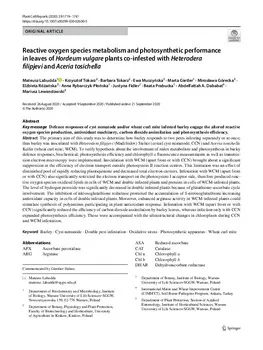Reactive oxygen species metabolism and photosynthetic performance in leaves of Hordeum vulgare plants co-infested with Heterodera filipjevi and Aceria tosichella

Abstract
The primary aim of this study was to determine how barley responds to two pests infesting separately or at once; thus barley was inoculated with Heterodera filipjevi (Madzhidov) Stelter (cereal cyst nematode; CCN) and Aceria tosichella Keifer (wheat curl mite; WCM). To verify hypothesis about the involvement of redox metabolism and photosynthesis in barley defence responses, biochemical, photosynthesis efficiency and chlorophyll a fluorescence measurements as well as transmission electron microscopy were implemented. Inoculation with WCM (apart from or with CCN) brought about a significant suppression in the efficiency of electron transport outside photosystem II reaction centres. This limitation was an effect of diminished pool of rapidly reducing plastoquinone and decreased total electron carriers. Infestation with WCM (apart from or with CCN) also significantly restricted the electron transport on the photosystem I acceptor side, therefore produced reactive oxygen species oxidized lipids in cells of WCM and double infested plants and proteins in cells of WCM-infested plants. The level of hydrogen peroxide was significantly decreased in double infested plants because of glutathione–ascorbate cycle involvement. The inhibition of nitrosoglutathione reductase promoted the accumulation of S-nitrosoglutathione increasing antioxidant capacity in cells of double infested plants. Moreover, enhanced arginase activity in WCM-infested plants could stimulate synthesis of polyamines participating in plant antioxidant response. Infestation with WCM (apart from or with CCN) significantly reduced the efficiency of carbon dioxide assimilation by barley leaves, whereas infection only with CCN expanded photosynthesis efficiency. These were accompanied with the ultrastructural changes in chloroplasts during CCN and WCM infestation.
